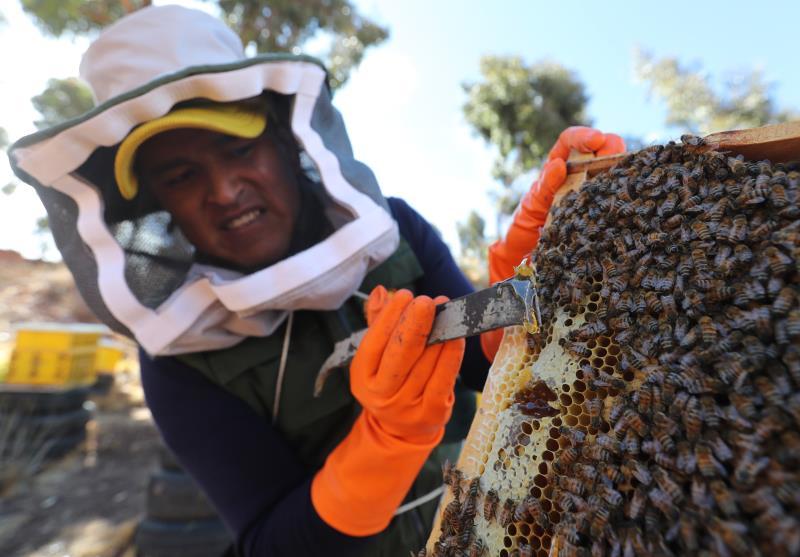A kingdom of bees in Bolivian heights on the shores of Lake Titicaca
The bees displaced from the Bolivian plains and valleys for climate change found a home in the highlands, some near Lake Titicaca where they could prosper more than 3,800 meters of altitude thanks to the beekeeping Wilder Humérez.
The beekeeping center "The Queen of the Lake" is the domain of at least one million bees living in the town of San Pablo de Tiquina, on the shores of Lake Titicaca, under the care of Humérez, an agronomist born in the place.
From farmers and fish farmers, Humérez was interested in beekeeping when he finished his university studies and did his degree thesis on the multiplication of queens, according to Efe.
Since 2013 it began with the production and sale of honey and its derivatives, and last year decided to open the center to visitors "with the aim of raising awareness among people" about "how important bees are in our environment."
"We offer a deep explanation to visitors about the Abejitas, how they live inside the hive, how they are organized," he explained.
The beekeeping center is about 15 minutes on foot from the Plaza de San Pablo de Tiquina, in a place surrounded by eucalyptus and other medicinal plants such as La Khoa, Thola, or La Chilca, whose flowers nourish their bees.
In his opinion, this makes the difference between honey produced in other places and that of its beekeeping center.

Home in the Altiplano
According to Humérez, climate change and excessive use of agrochemicals caused bees to migrate from low and warm areas such as the East, Valleys or Yungas de la Paz and establish "naturally" in the highlands.
"They settled in the ravines of the mountains, where there are holes that are the nests of the Andean carpenters called Yaca-Yacacas (...) It was a bit weird at first to see them there," he said.
To start his project, Humérez obtained a whole hive and began the raising of bees in handmade boxes, but soon saw that that was not optimal.
"If you do not give them the comfort they need, they will not produce honey either, then we were gradually implementing the technified boxes," said the beekeeper, who now uses Langstroth hives where the bees live at ease and respond positively "with theHoney production. "
The center currently has fifteen hives that house each to 50,000 to 100,000 bees that are already adapted to the cold and dry climate of the high plateau, since they generate among themselves the heat they require when the temperature descends.
Humérez has made genetic improvements to the insects of his center, with a hybrid between the European Apis Mellifera identified in the Altiplano, "which was initially a bit aggressive", and the Apis Mellifera Buckfast in pursuit of a more climate resistant breed, he explained.
The development of the center was not simple, because the engineer had to pay "floor right" with two bites that sometimes left his arms and face swollen.
But now the experience won has even led him to make bees of bees against stress, a therapy that is also available for visitors who wish to do it.
Bee life
The hives are in a land adjacent to Humérez's house from where the lake and a sign that warns that one is 3,810 meters above sea level is seen.
Visitors are previously placed special clothing to approach bees, while the beekeeper applies a smoke of sawdust that helps to calm them, he explained.
In each hive there is a queen who lives between three to seven years and feeds on real jelly.There are also workers' bees and zánganos, with a living time of two to four months and a diet consisting of honey porridge.
The collectors leave early in search of pollen and return with the legs loaded with small yellow, oranges or coffees, while the zánganos provide heat to the larvae.
In the Humérez Center it offers products such as honey, propolis, real jelly and derivatives such as lip balms, ointments, a propomiel spray and a wine with honey and cinnamon, all organic.
The beekeeper asked to become aware of the use of agrochemicals because they intoxicate bees.
In addition to caring for bees, the beekeeper considered that with his entrepreneurship he also helps to promote tourism in San Pablo de Tiquina beyond the traditional boat walks.
Gina Baldivieso


























Winter Prep List: How to Get Ready for Winter
06/06/2022Are you prepared for winter? It's not too late to get ready, but you'll want to take care of some important tasks in order to make sure you're prepared for the cold weather. This winter pr...